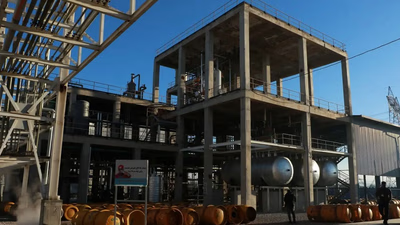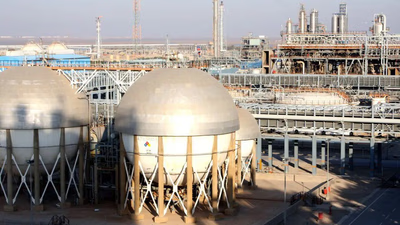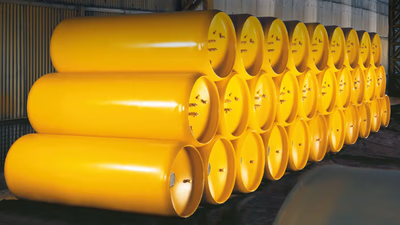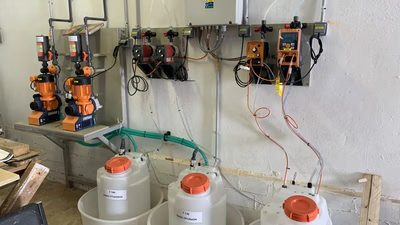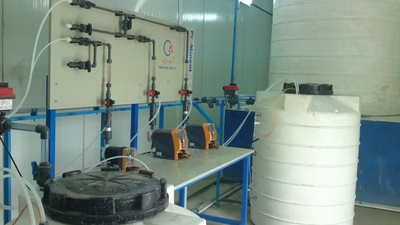
Chlorine production facilities in the Middle East enhance trade efficiency.
The region is rich in natural resources, particularly hydrocarbons such as natural gas and crude oil. Chlorine production often relies on feedstocks derived from these resources. Natural gas, in particular, serves as a primary feedstock for chlorine production through processes like electrolysis or as a source of hydrogen for other chemical reactions. The Middle East's ample reserves of natural gas provide a reliable and cost-effective feedstock for chlorine production. The Middle East's strategic geographical location plays a crucial role in its position as a major producer of chlorine. The region is well-positioned for global trade and has access to international markets, facilitating the export of chlorine and its derivatives to various regions around the world. Its proximity to major shipping routes and established trade networks enables efficient distribution and transportation of chlorine products.
Governments in the Middle East have actively supported the development of the chemical industry, including chlorine production. They have implemented policies and incentives to attract foreign investments, promote technology transfer, and facilitate the growth of domestic chemical companies. These supportive measures, such as tax incentives, infrastructure development, and favorable regulatory frameworks, have encouraged the establishment and expansion of chlorine production facilities in the region. The Middle East's chlorine production capabilities are driven by both domestic and global demand. Rapid population growth, urbanization, and industrialization within the region have increased the need for chlorine-based products, including water treatment chemicals, plastics, and industrial chemicals. Additionally, the Middle East's chlorine exports cater to the global market, meeting the demand for various applications across industries such as water treatment, pharmaceuticals, agriculture, and manufacturing.
Saudi Arabia is one of the major producers of chlorine in the region. The country has extensive natural gas reserves, which serve as a primary feedstock for chlorine production. Chlorine is produced through the process of electrolysis, where electricity is used to separate chlorine from brine (sodium chloride solution). Saudi Arabia has several large-scale chlorine production plants that cater to domestic and international markets. The UAE is another prominent player in chlorine production. The country has established integrated chemical complexes, such as the Industrial City of Abu Dhabi (ICAD) and Jebel Ali Industrial Area, which house chlorine manufacturing facilities. These facilities utilize natural gas or other feedstocks to produce chlorine through electrolysis or other chemical processes.
Countries in West Asia often engage in regional cooperation and trade to optimize resources and enhance chlorine production capabilities. For instance, they may collaborate in the establishment of joint ventures, sharing expertise, and exchanging feedstocks to facilitate efficient chlorine production and meet market demands. The specific details and capacities of chlorine production facilities can vary among countries and are subject to changes over time due to economic, technological, and geopolitical factors.
Chlorine is produced by electrolysis of brine containing sodium chloride. This element is found in nature only in combination with other elements, especially sodium in the form of table salt (NaCl), as well as in carnallite and sylvite. In order to prepare chlorine, according to the production method, a solution of brine and direct electricity are required. Arvand Petrochemical in Iran is the largest producer of chlorine in the Middle East, which in addition to meeting the needs of food, health and pharmaceutical industries, exports some of its products to European, African, South American and Asian countries.
Liquid chlorine is produced by reacting chlorine gas with caustic soda solution. The production process is such that caustic soda is poured into the storage tank and chlorine gas is introduced from the bottom. Chlorine gas is highly combinable with caustic soda, which causes chlorine gas to reach the top of the tank. In this case, the chlorine gas output is absorbed from the surface, the lower the gas output, the better the reaction. Tanks should be made of PVC because chlorine gas combines with any metal in the presence of moisture which leads to corrosion of the metal.
Qatar is known for its abundant natural gas reserves, which play a vital role in chlorine production. The country has invested in the development of large-scale chemical complexes, such as the Ras Laffan Industrial City, where chlorine production facilities are located. Qatar's chlorine production capacity supports both domestic consumption and export markets. Kuwait and Oman also have chlorine production capabilities. They utilize natural gas or other feedstocks to produce chlorine through electrolysis or other chemical processes. These countries have chemical industries that encompass various downstream applications of chlorine, such as PVC production, water treatment, and chemical manufacturing.
Several West Asian countries have invested heavily in developing integrated petrochemical complexes and industrial zones. These complexes house diverse chemical manufacturing facilities, including chlorine production plants. The availability of infrastructure, such as pipelines, storage facilities, and utilities, supports the efficient production and distribution of chlorine and its downstream products. The integration of different stages of the chemical value chain within these complexes enhances cost-effectiveness and competitiveness. Many West Asian countries have pursued economic diversification strategies to reduce their dependence on oil and gas revenues. The petrochemical and chemical industries, including chlorine production, represent a significant component of these diversification efforts. By expanding their chemical manufacturing sectors, these countries aim to generate new sources of revenue, create employment opportunities, and foster technological development.
